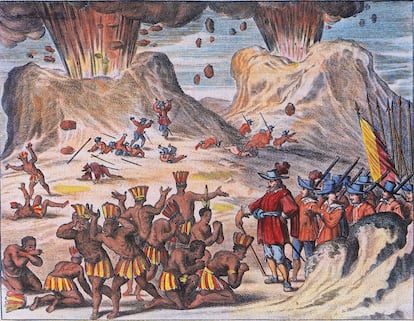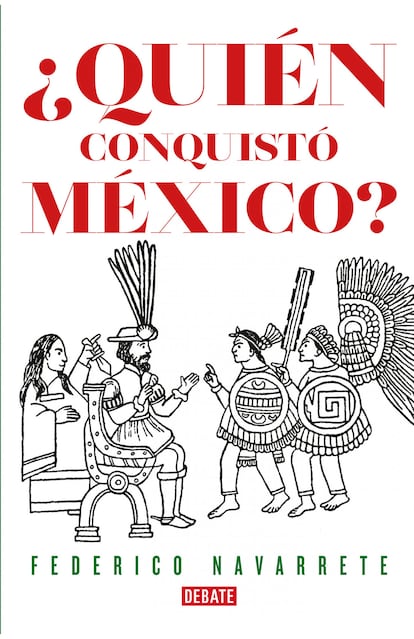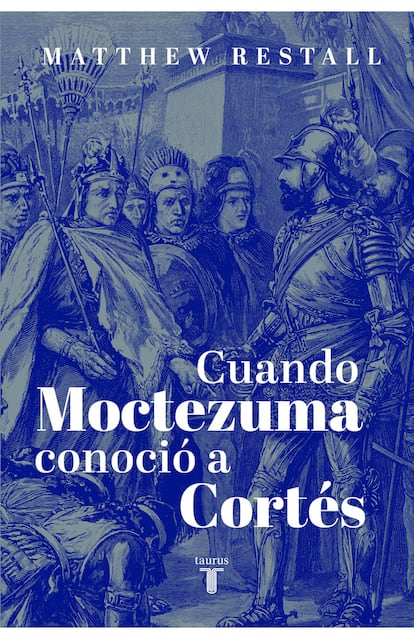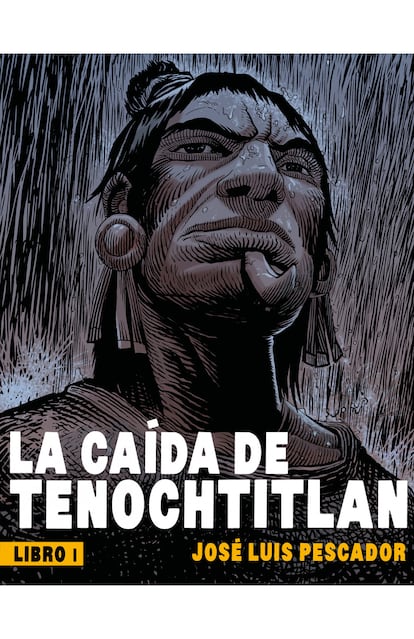The conquest of Mexico under question, 500 years on
August 13 marks half a millennium since the fall of the Aztec Empire, and dozens of new books are casting doubt on the version of history written by the victors

In his iconic 1995 book on the Haitian revolution, Silencing the Past, historian Michel-Rolph Trouillot wrote something that may appear obvious, but bears repeating: “Human beings participate in history both as actors, and as narrators.” History is not only what happened, but what we are told happened.
Of course, that does not mean that history is subjective, because some facts are undeniable: explorer Christopher Columbus arrived in America in 1492, and Spanish conquistador Hernán Cortés reached the shores of Veracruz, Mexico in 1519. But to understand the conquest of Mexico, we need to look at who was narrating it, as the angle or the sources they choose can tell us more about that moment than the facts themselves. “History is a consequence of power,” wrote Trouillot. “The most important task is not to determine what history is, but how it works.”

This year, August 13 marks the commemoration of 500 years since the ultimate fall of the Aztec Empire in modern-day Mexico. In the last two years, publishing houses in the country have produced dozens of new volumes questioning the credibility of the powerful storytellers who saw 1521 as a set victory of the Spanish over the Mesoamerican Indians. The full story of that battle, they say, was more complex.
“Every source is first and foremost a fact within its social, spatial and temporal context,” writes Luis Fernando Granados, a historian at Mexico’s Universidad Veracruzana, in his new book Relación de 1520 (or Record of 1520). He is critical of Hernán Cortés, considered the master storyteller of his time. In the book, Granados questions the credibility of the letters that the conquistador sent to the Spanish crown between 1519 and 1526, and that for centuries were taken as official accounts. Granados points out that there is no original manuscript from Cortés, but rather a transcription made years later by a scribe. There were letters written by several people, but these were political documents to the queen rather than a careful historical account. “If we stop considering them as the master version of Mexico’s past, that could have as refreshing an effect on the historiographical as on the purely historical,” he said. (Granados died in July of this year.)

One of the most interesting books on Cortés’ lack of credibility is entitled: ¿Quién conquistó México? (or Who Conquered Mexico?), by historian Federico Navarrete, and published by Debate books in 2019. This book poses different answers to the question of who conquered Mexico, and states: “It was La Malinche [Cortés’ consort], it was the indigenous conquerors.” Cortés, in reality, had a minuscule army when the Aztec Empire fell, and the real victors in August 1521 were his allies – the Mesoamerican enemies of the Aztec Empire, made up of indigenous warriors from Cempoala, Tlaxcala, Cholula, Texcoco and Chalco. “The idea of the absolute victory of the Spaniards in 1521 is nothing more than a partial and self-serving version, invented by Hernán Cortés himself, to extol and exaggerate his own role in the events,” the book adds.
Another narrator whose words were taken as gospel was Bernal Díaz del Castillo, conquistador and author of La Historia verdadera de la conquista de la Nueva España (or The True History of the Conquest of Nueva España”), whom Mexican writer Carlos Fuentes called Mexico’s “first novelist.” In 2019, the Taurus publishing house translated into Spanish When Montezuma Met Cortés: The True Story of the Meeting that Changed History, a work by US historian Matthew Restall dissecting official narratives, which begins by casting doubt on Díaz del Castillo’s credibility regarding Aztecan emperor Moctezuma and Cortés. The Aztec leader was neither cowardly nor naive, and Hernán Cortés was not a brilliant Spanish strategist, the book asserts. The victory of 1521 was, Restall insists, that of the conquering indigenous allies. He argues that what we now call “conquest” was a later and much more complex process.

“We have abandoned the term conquest, in the singular, and instead prefer the term conquests plural, in order to emphasize that the defeat of [the capital of the Aztec Empire] Tenochtitlan was only the beginning of a historical step,” writes historian Martín Ríos Saloma of the National Autonomous University of Mexico (UNAM). He has compiled essays by the best researchers in Mexico and Spain in his work Conquistas (or Conquests) released this year. His book makes an effort to search for the narrators whose past has been silenced, including “the voices of indigenous actors, of women, of the army captains, of the Castilian soldiers.” To ignore them, he believes, is to offer “a simplistic, Manichean and isolated vision of the historical processes happening in the world at that time.”
One of these silenced voices opens El quinto sol (or The Fifth Sun) by Camilla Townsend, translated into Spanish by the Grano de Sal publishing house this year. Chimalpahin, an indigenous historian who worked in a church, wrote in the evenings during his spare time to try and save the memory of his ancestors. To revisit writings like his, set down a century after 1521, is to deconstruct false narratives, Townsend says, offering the example of the exaggerated myth of Aztec human sacrifice. “The Aztecs were conquered, but they also saved themselves,” the author notes, “by writing down everything they could remember of their peoples’ history so that it would not be lost forever.”

The list of new publications in this year of commemoration can seem endless. Mexican historian Pedro Salmerón rejects the term conquest in La batalla por Tenochtitlan (or The Battle for Tenochtitlan). “The war was much more prolonged, the resistance was far greater and long-lasting and, in fact, it has not ended,” he stresses. Enrique Semo, in La conquista, catástrofe de los pueblos originarios (or The Conquest, Catastrophe of the Original Peoples) is more interested in the history of a new capitalist system present in Mesoamerica than in the date of 1521 itself. “Instead of eliminating or displacing the indigenous people in order to make use of empty spaces, the imperative was to reduce them to manageable groups,” he says.
Novelists and graphic novelists have also done their part as the anniversary approaches. The Planeta group published several novels this year focused on women. Montezuma’s daughter features in La otra Isabel (or The Other Isabel) by Laura Martínez-Belli, while Montezuma’s sex slave Malintzin appears in Amor y conquista (or Love and Conquest) by Marisol Martín del Campo. Meanwhile in El camino del fuego (or The Way of Fire), by Celia del Palacio, a Totanaca priestess allies herself with the Spaniards. Illustrator José Luis Pescador uses a comic book approach to tell the story of the war in La caída de Tenochtitlan (or The Fall of Tenochtitlan). They are all new narrators of what happened in 1521 – some more powerful than others – and they have created new accounts of the conquest, or conquests, that we are unsure how to name in the 21st century.
Tu suscripción se está usando en otro dispositivo
¿Quieres añadir otro usuario a tu suscripción?
Si continúas leyendo en este dispositivo, no se podrá leer en el otro.
FlechaTu suscripción se está usando en otro dispositivo y solo puedes acceder a EL PAÍS desde un dispositivo a la vez.
Si quieres compartir tu cuenta, cambia tu suscripción a la modalidad Premium, así podrás añadir otro usuario. Cada uno accederá con su propia cuenta de email, lo que os permitirá personalizar vuestra experiencia en EL PAÍS.
¿Tienes una suscripción de empresa? Accede aquí para contratar más cuentas.
En el caso de no saber quién está usando tu cuenta, te recomendamos cambiar tu contraseña aquí.
Si decides continuar compartiendo tu cuenta, este mensaje se mostrará en tu dispositivo y en el de la otra persona que está usando tu cuenta de forma indefinida, afectando a tu experiencia de lectura. Puedes consultar aquí los términos y condiciones de la suscripción digital.
More information
Archived In
Últimas noticias
Most viewed
- Reinhard Genzel, Nobel laureate in physics: ‘One-minute videos will never give you the truth’
- Pablo Escobar’s hippos: A serious environmental problem, 40 years on
- Charles Dubouloz, mountaineering star, retires at 36 with a farewell tour inspired by Walter Bonatti
- Why we lost the habit of sleeping in two segments and how that changed our sense of time
- The Florida Keys tourist paradise is besieged by immigration agents: ‘We’ve never seen anything like this’











































